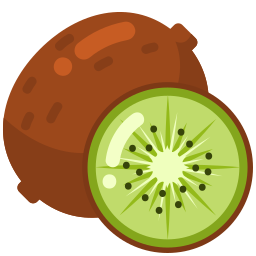
Kiwi fruit, commonly known as kiwifruit or simply kiwi, is an edible berry of several species of woody vines in the genus Actinidia. The most common cultivar group of kiwifruit is the Actinidia deliciosa, also known as the fuzzy kiwi, which is characterized by its brown, hairy skin and bright green flesh. Originating from China, kiwifruit is now grown in many countries, with significant production in New Zealand, Italy, and Chile.
Nutritional Profile
Kiwifruit is renowned for its impressive nutritional content. It is low in calories but high in essential vitamins, minerals, and antioxidants. A typical serving of kiwi (about one medium fruit) provides:
- Vitamin C: Over 100% of the daily recommended intake, making it one of the richest sources of this vital nutrient.
- Vitamin K: Important for blood clotting and bone health.
- Vitamin E: A fat-soluble antioxidant that helps protect cells from oxidative damage.
- Folate: Essential for DNA synthesis and repair.
- Potassium: Crucial for heart and muscle function.
- Dietary Fiber: Promotes digestive health and helps regulate blood sugar levels.
Additionally, kiwifruit contains smaller amounts of vitamins A and B6, magnesium, calcium, and phosphorus.
Health Benefits
The high nutrient density of kiwifruit translates into numerous health benefits:
- Immune Support: The high vitamin C content enhances the immune system, helping the body fend off infections.
- Digestive Health: The fiber in kiwifruit aids digestion and helps prevent constipation. The enzyme actinidin also helps break down protein, improving digestive efficiency.
- Heart Health: Kiwifruit’s combination of fiber, potassium, and antioxidants supports cardiovascular health by reducing blood pressure, lowering cholesterol levels, and preventing oxidative damage.
- Skin Health: The antioxidants and vitamins in kiwifruit contribute to healthy, glowing skin and may help prevent aging-related skin issues.
- Eye Health: The presence of lutein and zeaxanthin, antioxidants found in kiwifruit, supports eye health and helps prevent age-related macular degeneration.
Culinary Uses
Kiwifruit’s unique flavor, a sweet-tart blend, makes it a versatile ingredient in the kitchen. It can be eaten fresh, added to fruit salads, blended into smoothies, or used as a topping for desserts and yogurt. Its vibrant green color and distinctive taste also make it an attractive garnish for various dishes. In addition to its culinary applications, kiwifruit can be used in marinades due to its natural tenderizing properties.
Cultivation and Varieties
Kiwifruit grows on climbing vines that require a temperate climate with adequate sun and well-drained soil. It is typically harvested in late autumn when the fruit reaches optimal ripeness. Several varieties of kiwifruit exist, including:
- Hayward: The most common variety, known for its large size and sweet, tangy flavor.
- Golden Kiwi: With smooth, bronze skin and yellow flesh, this variety is sweeter and less acidic than the green kiwifruit.
- Baby Kiwi: Also known as kiwi berries, these are smaller, grape-sized kiwis with smooth, edible skin and a flavor similar to traditional kiwifruit.
Fun Facts
- The name “kiwifruit” comes from the kiwi bird, a native bird of New Zealand, due to the fruit’s resemblance to the bird in terms of color and texture.
- Kiwifruit was originally known as “Chinese gooseberry” before New Zealand growers rebranded it for better market appeal.
In summary, kiwifruit is a superfruit packed with essential nutrients and health benefits. Its diverse culinary uses and appealing taste make it a favorite for both everyday consumption and gourmet cooking. Whether enjoyed fresh, blended into a smoothie, or used as a tenderizer, kiwifruit is a delicious and nutritious addition to any diet.